|
Georgetown,
Exuma Islands, Bahamas to Florida
27th
March - 20th April 2009
|
|
Whilst we'd been taking it easy, enjoying the
fun in Georgetown, our buddies Chris and Vivian had undertaken an exciting
circumnavigation of Long Island, on their power boat, Second
Chance. Spurred on by information from locals that there
was "no way a boat of their draft could possibly pass through the
shallows south of Thomson Bay", they went anyway.
With much tidal planning and depth sounding of the channel, which they
marked with their own buoys, they succeeded and had gone on to visit some of
the more remote islands further east. We could only dream
of many of the spots they had reached, as they were no place to venture in
Anju with her two metre draft!
|
|
In true Chris and Vivian style, they had arrived
back in the Georgetown anchorage half an hour before a beach rock'n'roll
party, where we all danced late into the night.
Next day it was time for "Show and
Tell", the girls compared their respective hauls of beach treasure and
worked together on their craft projects.
All too soon it was time for Anju to start
the 700 mile trek northwards again, we had a date with an airplane to the
UK. We wanted to make another stop, this time definitely
only a few days, at the Exuma Park, for a spot more volunteering. We
hoped to stop at Cambridge Cay for a night on the way north
too.
|
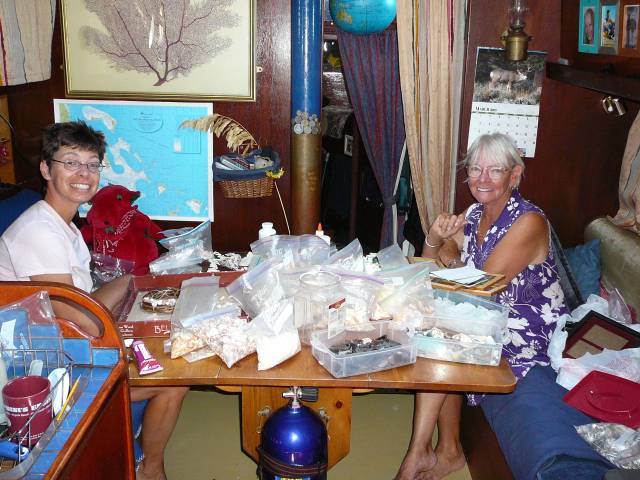
Girls, just where are we
going to keep all that treasure??
|
|
Headed north in a total dead calm, on the deep
side of the Exuma chain, suddenly our trusty new motor just
stopped. Captain Phil rushed below to investigate,
whilst Christine kept an eye on things on deck, to make sure we didn't drift
into Staniel Cay. Nothing obvious was amiss so, in
desperation, we turned on the supply from all three diesel tanks (normally
we only used one at a time). With no wind to keep us out
of trouble, we needed to get the motor running quickly before the tide began
to carry us towards danger. We turned the ignition key and
our new electric, self-bleeding fuel pump did its job, the motor started and
we were underway again. However, we were now nervous about
approaching unknown Cambridge Cay through a narrow reef-lined channel, when
we still had doubts about the motor. Instead, we diverted
straight to Warderick Wells and took the only available mooring in the
beautiful, secluded south anchorage.
Later investigation revealed the cause of the
problem, which turned out not to be a mechanical malfunction at all, but
human error. Obviously if you had took your fuel
supply from one fuel tank and accidentally switched the surplus fuel return
to a different tank, the fuel tank supplying the diesel to the motor emptied
very quickly, at which point the engine would suddenly stop.
Potentially, unless discovered in time, the surplus fuel could have quickly
overfilled the other tank. We had never had this problem
on the old engine which somehow ran for decades with no surplus fuel return
pipes at all! Out came the marker pen and the supply and
return valves were labelled in HUGE letters.
|
|
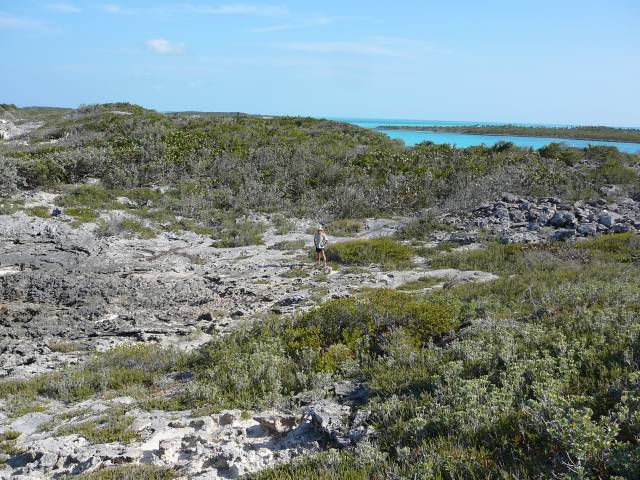
|
Our problems solved, we had the afternoon to
explore the small island beside the anchorage, which we had never
visited. We spent a couple of interesting hours
investigating the strange landscape of rock with eroded holes filled with
dried sea salt. We also enjoyed a wonderful snorkel amongst
beautiful, brightly coloured corals right there in the anchorage.
Phil goes exploring
|
|
Next day Judy quickly found us a mooring near
the Park Headquarters, keen to get us back to work. We spent a
few days making repairs to the Park's fleet of boats. One day, we were
despatched with George from Seaquel, in one of the Park boats, to Shroud Cay for a spot
of sign erection. We made a stop on the long trip north to drop
off fellow volunteer Bruce at Cistern Cay, where he would be
working.
To reach "Camp Driftwood" on the
eastern side of Shroud Cay we had to navigate our way through the shallow
mangrove-lined channel across the island. It proved no easy task
handling the relatively large boat around the tight and shallow bends but
George's excellent helming got us there without running
aground. Next, we carried the sign, the concrete, the
water to mix the concrete and all the tools up the steep hill to the correct
location. A spot had to be found where, not only
could the sign be read easily from whichever direction visitors approached,
but where the ground had something other than rock, to allow us to dig holes
for the sign's frame. By the time the work was complete and we
were ready to head back, the tide was very low, making navigation through
the mangroves even more tricky. Phil stood on the bow
directing us to the deeper water and finally we escaped the
shallows.
In the anchorage at Shroud Cay, there was
little evidence of the supposed "credit-crunch" as we wove our way
through around a dozen Mega-yachts on our way back to the
Park! Perhaps that was where all the missing money had
gone!
|
|
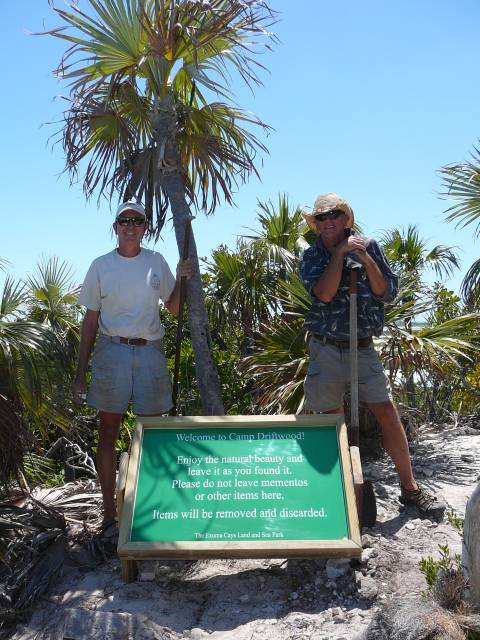
George and Phil's handiwork
|
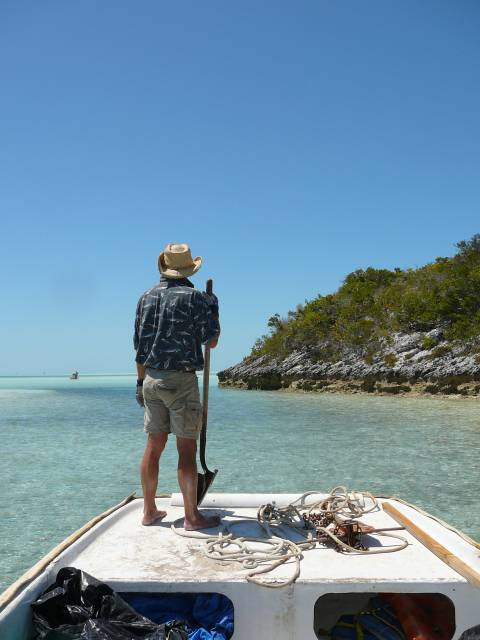
Just what is he planning to
do with the shovel? Dredge a channel?
|
|
We had to make a stop at Cistern Cay on the
way back. It appeared that the low tide had taken the local
conch population by surprise too, as the beach was littered with young
conch, left high and dry.
Our other major volunteering task for the
Park during that visit was to be assisting with the traditional Easter
Sunday Pot Luck lunch on the beach. The day turned out to
be incredibly hot and we were almost fried whilst lugging tables and chairs
and setting things up. We were definitely grateful when Tom and
Judy invited us into their house for a cool drink until the ham and turkey
provided by the Park were
cooked.
|
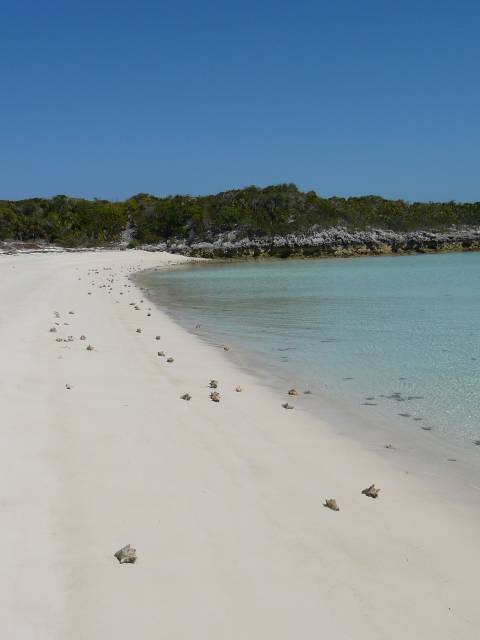
Where did the sea go guys?
|
|
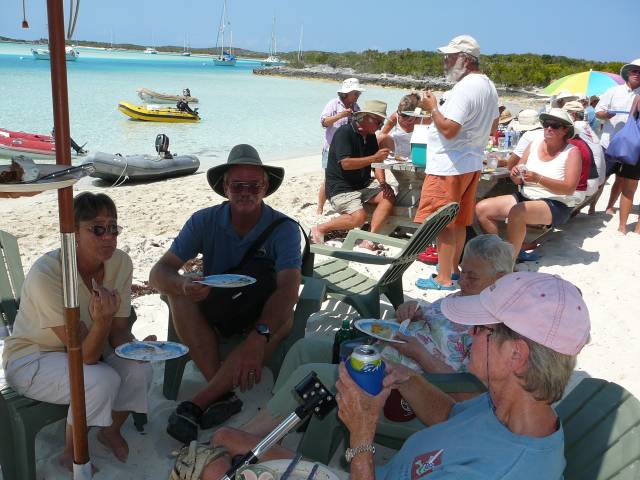
Easter Sunday Lunch
|
When they were ready, Phil and John set to work
with electric carving knives (thank goodness) and after an hour of carving,
they had produced several huge platters of meat for the
feast. We staggered down to the beach with the mountain of
food. We were joined by thirty or forty cruisers and their pot-luck
contributions of side dishes and desserts. It was quite a
feast and a lot of fun.
The next day it was time to get underway
again and we headed out eastwards into the Exuma Sound, bound for Eleuthera.
|
|
Only a couple of miles out we had a very close
encounter with a large whale. First we spotted the
telltale spout of water, as the whale surface to breathe. We
then watched in awe as the huge animal, longer than our boat, passed right
in front of our bow, before making a U-turn to swim back for a second
look.
We had picked a day when we could actually
sail across the Exuma Sound. However the last 10 miles into Rock
Sound was a different course and, of course, straight into 20+ knots of wind
and pretty unpleasant.
We hid out there for a couple of days, in
water little deeper than poor Anju's bottom, through another blow before
setting sail again.
|
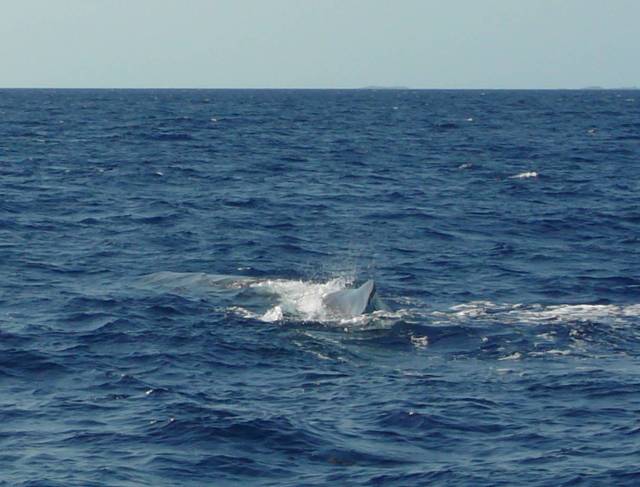
Close Encounters of the
fifty foot kind...
|
|
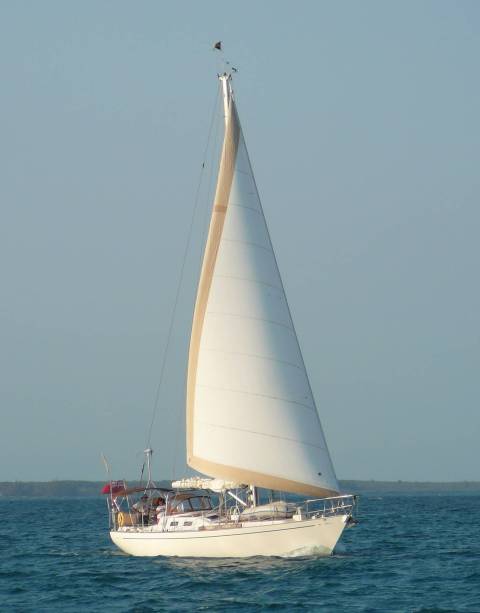
Al Shaheen safely through
Current Cut
|
We had a lovely forecast of 15 knots of easterly
wind, dropping off later in the day, which promised a delightful sail
to the NW. Unfortunately the reality was nearer 25, gusting
higher, and after the catamaran in front of us blew out their mainsail and
returned to port, we began to wonder if ours was the only boat out there.
This proved not to be the case.
We were delighted on reaching the somewhat rolly anchorage near Current Cut,
to find OCC friends we hadn't seen for several years, John and Jenny on Al
Shaheen.
Passage through the Cut can be tricky, as the tide rips
through the narrow passage between the rocks. We took our
boats through the Cut together and then spent three days anchored with them
at Royal Island, waiting for weather to make the crossing to
Florida. We were disappointed to find that you could no longer
go ashore due to development on the island.
|
|
It was probably fortunate that there was nowhere
to go from the anchorage by dinghy. During our only trip
up the harbour to take a look at the new developments, our propeller decided
it was time for it to part company with the rubber shock-absorbing liner on
the shaft. This left us some distance up the harbour, with an
outboard engine, which when you applied revs turned only the shaft, the
propeller and the dinghy stubbornly remained motionless.
We managed to limp the dinghy at very low revs back to our
yacht. Again Superglue came to our aid and the rubber liner was
temporarily glued to the propeller, allowing us to at least venture over to
visit our neighbours John and Jenny at low speed. Whether
the two sections of the propeller would ever be able to be parted again for
a proper repair was a subject of debate but at least we weren't stuck aboard
Anju in the meantime.
|
|
We'd been waiting for huge Atlantic swells to
calm down before our departure for Florida, a trip of about 200 miles.
We knew the first, exposed leg of the trip between Royal and Grand Bahama
Islands was going to be lumpy. The 8 - 10 foot swells quickly found
everything we hadn't stowed properly. We enjoyed a
calmer day at sea once in the lee of Grand Bahama Island and finally landed our
first Mahi Mahi, in fact our first fish of the trip. It
had been a poor year for us for fishing, lots of hits but plenty of lost
lures and broken equipment. It seemed the fish we were encountering
were just too big or too cunning.
We started the Gulf Stream crossing over to
Florida in the middle of the night. Again, we'd been
promised 15 - 20 knots of wind but ended up reefing at 4 am when the dial
suddenly hit 35 knots. After a half hour of trauma, by 4.30 am
Christine, the watchkeeper, was dreaming of a home that didn't move at
all. Fortunately the feeling was short-lived.
|
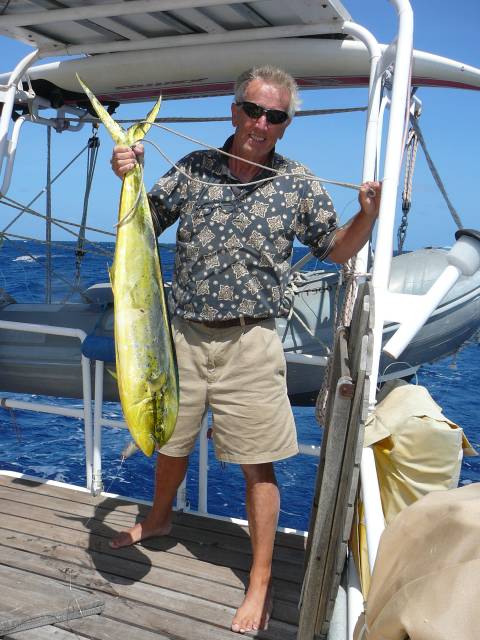
|
|
The Captain's decision to keep our speed up and
make an earlier landfall at West Palm Beach proved to be an excellent
one. We surfed downwind
through the breakwater into West Palm Beach and dropped our hook next to
speedier Al Shaheen around lunchtime. A couple of hours later, the forecast
apocalyptic thunderstorms hit the anchorage and we were glad to be safely
anchored. Fortunately the Immigration Regulations in West
Palm Beach allowed us 24 hours to get to the office and check in after
phoning, so we didn't have to risk life and limb in the appalling weather.
|








